I would use list to keep all DataFrames
all_df = [] # list
all_df.append(df_1)
all_df.append(df_2)
and then I would no need exec
for rows in df_list.itertuples():
row = rows.Index
ind_id = df_list.loc[row]['Prodinfo']
print(row, ind_id)
all_df[row]["rank"] = all_df[row][ind_id].rank(ascending=True)
Eventually I would use dictionary
all_df = {} # dict
all_df['PRODUCT.AREA'] = df_1
all_df['PRODUCT.CODE'] = df_2
and then I don't need exec and df_list
for key, df in all_df.items():
df["rank"] = df[key].rank(ascending=True)
Minimal working code with list
import pandas as pd
all_df = [] # list
datum = {
'Products': ['Stocks', 'Bonds', 'Notes'],
'PRODUCT.AREA': ['10200', '50291', '50988']
}
all_df.append( pd.DataFrame(datum) )
datum = {
'Products': ['Stocks', 'Bonds', 'Notes'],
'PRODUCT.CODE': ['66', '55', '22']
}
all_df.append( pd.DataFrame(datum) )
#print( all_df[0] )
#print( all_df[1] )
print('--- before ---')
for df in all_df:
print(df)
summary = {'Prodinfo': ['PRODUCT.AREA', 'PRODUCT.CODE']}
df_list = pd.DataFrame(summary, columns=['Prodinfo'])
#print(df_list)
for rows in df_list.itertuples():
row = rows.Index
ind_id = df_list.loc[row]['Prodinfo']
#print(row, ind_id)
all_df[row]["rank"] = all_df[row][ind_id].rank(ascending=True)
print('--- after ---')
for df in all_df:
print(df)
Minimal working code with dict
import pandas as pd
all_df = {} # dict
datum = {
'Products': ['Stocks', 'Bonds', 'Notes'],
'PRODUCT.AREA': ['10200', '50291', '50988']
}
all_df['PRODUCT.AREA'] = pd.DataFrame(datum)
datum = {
'Products': ['Stocks', 'Bonds', 'Notes'],
'PRODUCT.CODE': ['66', '55', '22']
}
all_df['PRODUCT.CODE'] = pd.DataFrame (datum)
print('--- before ---')
for df in all_df.values():
print(df)
for key, df in all_df.items():
df["rank"] = df[key].rank(ascending=True)
print('--- after ---')
for df in all_df.values():
print(df)
Frankly, for two dataframes I wouldn't waste time for df_list and for-loop
import pandas as pd
datum = {
'Products': ['Stocks', 'Bonds', 'Notes'],
'PRODUCT.AREA': ['10200', '50291', '50988']
}
df_0 = pd.DataFrame(datum)
datum = {
'Products': ['Stocks', 'Bonds', 'Notes'],
'PRODUCT.CODE': ['66', '55', '22']
}
df_1 = pd.DataFrame(datum)
print('--- before ---')
print( df_0 )
print( df_1 )
df_0["rank"] = df_0['PRODUCT.AREA'].rank(ascending=True)
df_1["rank"] = df_1['PRODUCT.CODE'].rank(ascending=True)
print('--- after ---')
print( df_0 )
print( df_1 )
And probably I would even put all in one dataframe
import pandas as pd
df = pd.DataFrame({
'Products': ['Stocks', 'Bonds', 'Notes'],
'PRODUCT.AREA': ['10200', '50291', '50988'],
'PRODUCT.CODE': ['66', '55', '22'],
})
print('--- before ---')
print( df )
#df["rank PRODUCT.AREA"] = df['PRODUCT.AREA'].rank(ascending=True)
#df["rank PRODUCT.CODE"] = df['PRODUCT.CODE'].rank(ascending=True)
for name in ['PRODUCT.AREA', 'PRODUCT.CODE']:
df[f"rank {name}"] = df[name].rank(ascending=True)
print('--- after ---')
print( df )
Result:
--- before ---
Products PRODUCT.AREA PRODUCT.CODE
0 Stocks 10200 66
1 Bonds 50291 55
2 Notes 50988 22
--- after ---
Products PRODUCT.AREA PRODUCT.CODE rank PRODUCT.AREA rank PRODUCT.CODE
0 Stocks 10200 66 1.0 3.0
1 Bonds 50291 55 2.0 2.0
2 Notes 50988 22 3.0 1.0


